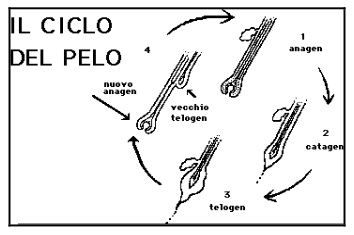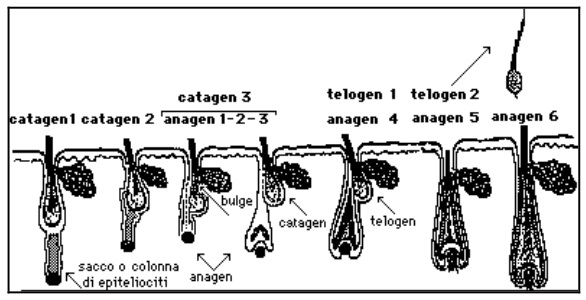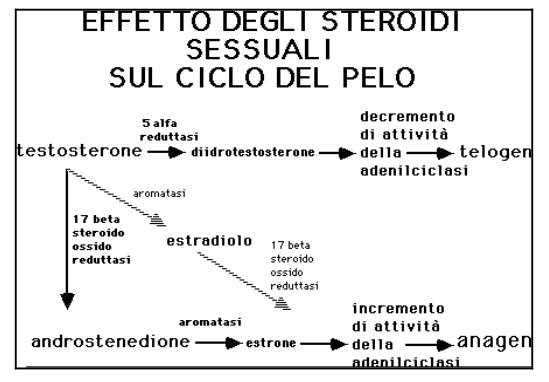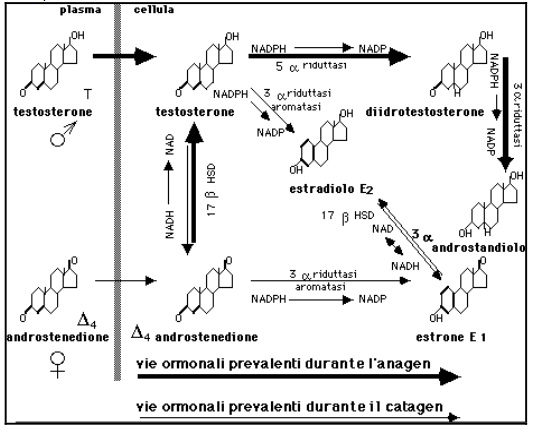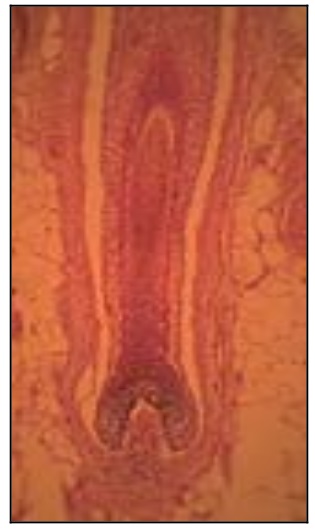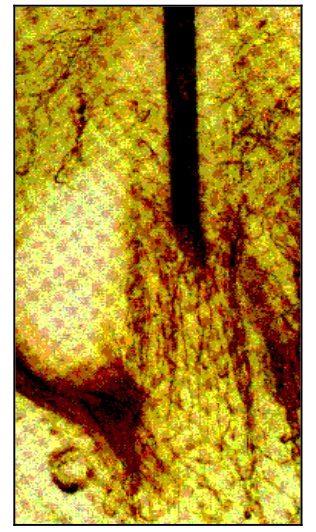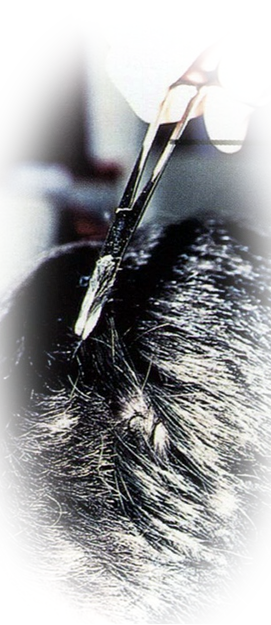 Edizioni Elettroniche TricoItalia®
Edizioni Elettroniche TricoItalia®
STAMPATO IN PROPRIO – NON COMMERCIABILE
Proprietà letteraria ed artistica riservata a S.I.Tri.®
– TricoItalia.®
Nessuna parte di quest’opera può essere riprodotta senza consenso scritto.
Quanto troverai in questo file, per precisa volontà degli Autori, può comunque essere usato per pubblicazioni, lavori scientifici, articoli etc…ma sempre citandone la fonte!
Il ciclo ideale del capello
THE IDEAL HAIR CYCLE
LE CYCLE IDÉAL DU CHEVEU
Andrea Marliani*, Paolo Gigli *, Marino Salin**
Scuola Internazionale di Medicina Estetica*   F.I.F. TricoItalia®**
01) Presentiamo il ciclo ideale del capello come appare raffrontando le immagini istologiche con l’aspetto dei capelli estratti ed osservati in microscopia a luce polarizzata.
Da questo raffronto scaturiscono alcune “nuove acquisizioni sul ciclo del capello†di notevole interesse nosologico e non prive di importanza anche su piano terapeutico.
Va precisato che parliamo di un capello “perfetto†ed “idealeâ€, un anagen VII, cioè di un capello con durata della fase anagen di 4 – 10 anni, tipico del sesso femminile, del bambino pre pubere, della donna giovane e/o gravida, un capello che si presenta con guaine massicce e ben conformate, massima profondità bulbare, fra 7 e 8 mm, massima rapidità di crescita, circa 400 micron al giorno (12 mm al mese).
I capelli comuni, quelli di quasi tutti noi, sono, nel migliore dei casi, anagen VI.
Dobbiamo precisare che non tutte le immagini che qui Vi mostriamo sono originali ma, in parte, le abbiamo tratte da atlanti di dermatologia o anatomia in commercio.
01) We present the ideal hair cycle by comparing histologic images with the appearance of hairs removed and examined by microscope in polarised light.
From this comparison we obtain new insights into the hair cycle which are of considerable nosological interest and are not without therapeutic value as well.
It should be made clear that we are here speaking about the “perfect†or “ideal†hair, an anagen VII, that is to say a hair with a duration in anagen of 4 – 10 years typical of the female sex, of the pre-pubescent child, of the young and/or pregnant woman, a hair characterised by a thick and well-formed sheath, maximum depth of bulb (between 7 and 8 mm), maximum rate of growth approximately 400 microns per day, or 12 mm per month).
Ordinary hairs, such as most of us possess, are at best in anagen VI. It should further be stressed that not all the images we are showing you are original. Same have been taken from published atlases of dermatology or anatomy.
01) Nous présentons le cycle idéal du cheveu tel qu’il apparaît en comparant les images histologiques avec l’aspect des cheveux extraits et observés au microscope polarisant.
De cette comparaison émergent de “nouvelles acquisitions sur le cycle du cheveu†d’un grand intérêt nosologique et d’une certaine importance sur le plan thérapeutique.
Il faut préciser que l’on parle d’un cheveu “parfait†et “idéalâ€, d’un anagène VII, c’est-à -dire d’un cheveu dont la durée de la phase anagène va de 4 à 10 ans, typique du sexe féminin, de l’enfant pré-pubère, de la femme jeune et/ou enceinte, un cheveu qui se présente avec des gaines pleines et bien constituées, profondeur bulbaire maximum entre 7 et 8 mm, rapidité de croissance maximum d’environ 400 microns par jour (12 mm par mois).
Les cheveux communs, ceux de la plupart d’entre nous, sont, dans le meilleur des cas, des
anagènes VI. Précisons que les images que nous vous montrons ici ne sont pas toutes originales, mais proviennent, en partie, d’atlas de dermatologie ou d’anatomie qui se trouvent dans le commerce.
02) Il ciclo del capello e del pelo (anagen, catagen, telogen), è quel ricambio necessario ad impedire che, in natura, l’annesso cresca indefinitamente ed, in definitiva, per impedire che un individuo di 50 anni abbia peli e capelli lunghi 6 metri.
Classicamente leggiamo e diciamo che la fase anagen dura mediamente 1000 giorni, la fase catagen 10 giorni, la fase telogen 100 giorni.
02) The hair cycle (anagen, catagen, telogen) is that series of changes which is necessary to ensure that the adnexum does not grow indefinitely, and that an individual of 50 years of age does not have hair six metres long.
Classically we read and we say that the anagen phase lasts an average of 1000 days, the catagen phase 10 days, and the telogen phase 100 days.
02) Le cycle du cheveu et du poil (anagène, catagène, télogène), c’est la repousse nécessaire pour empêcher que, dans la nature, l’annexe croisse indéfiniment et, en définitive, pour empêcher qu’à 50
ans un individu ait des poils et des cheveux de 6 m de long. On lit et on dit couramment que la phase anagène dure en moyenne 1000 jours, la phase catagène 10 jours et la phase télogène 100 jours.
03) Un altro modo di rappresentare il ciclo ci fa vedere che quando un “vecchio†capello è in telogen il follicolo è già in anagen IV, e ci fa capi re che l’anagen ed il catagen sono fasi del follicolo mentre il telogen è solo una fase del capello, che cade fisiologicamente.
03) Another way of representing the hair cycle shows us that when an “old†hair is in the telogen phase the follicle is still in anagen IV, and thus that the anagen and the catagen are phases of the follicle whereas the telogen is a phase only of the hair, which faIls out for physiological reasons.
03) Une autre façon de représenter le cycle nous fait voir que lorsqu’un “vieux†cheveu est en télogène, le follicule est déjà en anagène IV, ce qui nous fait comprendre que l’anagène et le catagène sont des phases du follicule, tandis que le télogène n’est qu’une phase du cheveu, qui tombe physiologiquement.
04) Fondamentalmente il capello controlla il suo ciclo attraverso il metabolismo degli androgeni. Il capello, durante l’anagen, tramite la 5 alfa riduzione del testosterone, provoca decremento di attività della adenilciclasi e quindi della esochinasi, che permette al glucosio di accedere alla glicolisi, con riduzione di attività di questa via metabolica fino al blocco delle mitosi della matrice ed al telogen. In modo bilanciato, attraverso la 17 beta steroidodeidrogenasi e l’aromatasi, produce anche estrone solo quanto gli è sufficiente a mantenere l’attività fisiologia della adenilciclasi, cioè le mitosi della matrice e la durata dell’anagen.
Facciamo subito notare, facendo un salto pindarico ai risvolti terapeutici, come tutti i tentativi di “terapia†medica della così detta “alopecia androgenetica†si sono fino ad oggi limitati al tentativo di incrementare la durata dell’anagen o bloccando la 5 alfa riduzione con inibitori ormonali o mimando il fattore di crescita del bulge con il minoxidil.
04) Basically the hair governs its cycle by means of the metabolism of androgens. During the anagen phase, by means of 5 alpha reduction of testosterone the hair causes a decrease in the activity of adenyl cyclase and therefore of hexokinase, allowing the glucose to attain glucolysis with the reduction of this metabolic means, leading to blocking of the mitoses of the matrix and to the telogen phase. In balanced fashion, by means of 17 beta. steroidodeidrogenasis and aromatasis, it produces only as much estrone as is sufficient to ma intain the physiological activity of the adenylcyclase, that is to say the mitoses of the matrix and the duration of the anagen.
We should at once point out digressing for a moment into therapeutic considerations, that all attempts at medical “therapy†in cases of so-called “androgenetic alopecia†have until now been restricted to increasing the duration of the anagen, or blocking the 5 alpha reduction with hormonal inhibitors, or miming the bulge growth factor with minoxidil.
04) Fondamentalement, le cheveu contrôle son cycle à travers le métabolisme des androgènes.Pendant l’anagène, à travers la 5 alpha réduction du testostérone, le cheveu entraîne une diminution de l’activité de l’adénylcyclase et donc de l’exokynase, qui permet au glucose d’accéder à la glycolyse, avec réduction de l’activité de cette voie métabolique jusqu’au blocage des mitoses de la matrice et au télogène.
D’une façon équilibrée, à tavers la 17 béta stéroïdo-déhydrogénase et l’aromatase, il produit également de l’oestrone en quantité suffisante pour maintenir l’activité physiologique de l’adénylcyclase, c’est-à -dire les mitoses de la matrice et la durée de l’anagène. Il faut souligner, en ce qui concerne les effets thérapeutiques, que toutes les tentatives de “thérapie†médicale de ce qu’on appelle l’“alopécie androgéno-génétique†se sont jusqu’à présent limitées à la tentative d’augmenter la durée de l’anagène ou en bloquant la 5 alpha réduction avec des inhibiteurs hormonaux ou encore en mimant le facteur de croissance du ‘bulge’ avec le minoxydyl.
05) Nella donna il diidrotestosterone, necessario al telogen, dovrà essere prodotto dal follicolo mediante riduzione a testosterone del principale androgeno circolante nel sesso femminile, l’androstenedione.
Il testosterone potrà poi prendere la via della 5 alfa riduzione a diidrotestosterone. Nel maschio la via della 5 alfa riduzione è invece da testosterone, quindi più diretta.
E’ quindi chiaro come nel maschio la via metabolica privilegiata è quella della 5 alfa riduzione a diidrotestosterone, mentre nella femmina è assai facile la aromatizzazione dell’androstenedione ad estrone.
Appare comprensibile perché la durata dell’anagen del maschio è circa metà di quella della femmina e perché nel sesso femminile l’alopecia androgenetica è assai più rara.
05) In women the dihydrotestosterone necessary for the telogen is produced by the follicle by means of reduction to testosterone of the principal androgen in females, androstenedione.
The testosterone can then undergo 5 alpha reduction to dihydrotestosterone. In men the 5 alpha reduction is from testosterone and is therefore more direct.
It is evident that in males the privileged metabolic means are those of 5 alpha reduction to dihydrotestosterone, whereas in females we have the aromatisation of androstenedione to estrone
This explains why the duration of the anagen phase in males is about half that in females, and why androgenetic alopecia is very much rarer in women.
05) Chez la femme, le dihydrotestostérone, nécessaire au télogène, devra être produit par le follicule à travers la réduction en testostérone du principal androgène circulant dans le sexe féminin, l’androstènedione.
Le testostérone pourra alors prendre la voie de la 5 alpha réduction en dihydrotestostérone.
Chez l’homme, la voie de la 5 alpha réduction part du testostérone et est donc plus directe.
Il est clair, par conséquent, que chez l’homme la voie métabolique privilégiée est celle de la 5 alpha réduction en dihydrotestostérone, tandis que chez la femme l’aromatisation de l’androstènedione en oestrone est extrêmement facile.
On comprend donc pourquoi la durée de l’anagène de l’homme est d’environ la moitié de celle de la femme et pourquoi, dans le sexe féminin, l’alopécie androgéno-génétique est beaucoup plus rare.
06) Una immagine clinica di un soggetto con capelli anagen VII.
06) A clinical image of a subject with anagen VII hair.
06) Une image clinique d’un sujet avec des cheveux anagène VII.
07) Istologia di un capello anagen VII.
Facciamo notare come il bulbo è circondato da cellule adipose, quindi profondo nell’ipoderma sottocutaneo circa 7 mm, cioè 7000 micron.
07) Histology of hair in anagen VII.
Note the bulb is surrounded by adipose cells, and is therefore about 7 mm or 7000 microns deep in the subcutaneous hypodermis.
07) Histologie d’un cheveu anagène VII.
Remarquons que le bulbe est entouré de cellules adipeuses et qu’il pénètre donc dans le tissu sous-épidermique à une profondeur d’environ 7 mm, soit 7000 microns.


